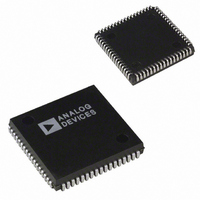ADMC201AP Analog Devices Inc, ADMC201AP Datasheet - Page 8

ADMC201AP
Manufacturer Part Number
ADMC201AP
Description
IC MOTION CO-PROC 25MHZ 68PLCC
Manufacturer
Analog Devices Inc
Datasheet
1.ADMC201AP.pdf
(15 pages)
Specifications of ADMC201AP
Rohs Status
RoHS non-compliant
Applications
*
Mounting Type
Surface Mount
Package / Case
68-PLCC
Operating Temperature (min)
-40C
Operating Temperature (max)
85C
Operating Temperature Classification
Industrial
Mounting
Surface Mount
Lead Free Status / RoHS Status
Not Compliant
Available stocks
Company
Part Number
Manufacturer
Quantity
Price
ADMC201
VECTOR TRANSFORMATION BLOCK OVERVIEW
The Vector Transformation Block performs both Park and
Clarke coordinate transformations to control a three-phase
motor (Permanent Magnet Synchronous Motor or Induction
Motor) via independent control of the decoupled rotor torque
and flux currents. The Park & Clarke transformations combine
to convert three-phase stator current signals into two orthogonal
rotor referenced current signals Id and Iq. Id represents the flux
or magnetic field current and Iq represents the torque generat-
ing current. The Id and Iq current signals are used by the
processor’s motor torque control algorithm to calculate the re-
quired direct Vd and quadrature Vq voltage components for the
motor. The forward Park and Clarke transformations are used
to convert the Vd and Vq voltage signals in the rotor reference
frame to three-phase voltage signals (U, V, W) in the stator ref-
erence frame. These are then scaled by the processor and
written to the ADMC201’s PWM registers in order to drive the
inverter. The figures below illustrate the Clarke and Park
Transformations respectively.
I
y
Reference Frame
Reference Frame
120
V
Figure 7. Reverse Clarke Transformation
Stationary
q
Stator Currents
Rotating
Figure 9. Forward Park Transformation
Figure 8. Reverse Park Transformation
I
w
I
v
Three-Phase
120
120
I
x
V
d
I
u
Two-Phase Currents
Reference Frame
Equivalent
Reference Frame
I
y
Stationary
Rotating
90
90
I
I
d
q
ROTOR
REFERENCE
FRAME AXIS
V
V
I
x
y
x
–8–
Operating/Using the Vector Transformation Block
After powering up the ADMC201, RESET must be driven
low for a minimum of two clock cycles to enable vector
transformations.
The vector transformation block can perform either a forward or
reverse transformation.
Reverse Transformation is defined by the following operations:
(a) Clarke: 3-phase current signals to 2-phase current signals
followed by (b) Park: 2-phase current signals cross multiplied by
sin , cos
with respect to the rotor (stationary) where is the electrical
angle of the rotor field with respect to the stator windings.
Forward transformation is defined by the following operations:
(a) Park: 2-phase voltage signals cross multiplied by sin , cos fol-
lowed by (b) Clarke: 2-phase to 3-phase voltage signal conversion.
In order to provide maximum flexibility in the target system, the
ADMC201 operates in an asynchronous manner. This means
that the functional blocks (analog input, reverse transformation,
forward transformation and PWM timers) operate indepen-
dently of each other. The reverse and forward vector
transformation operations cannot occur simultaneously. All
vector transformation registers, except for RHO/RHOP, are
twos complement. RHO/RHOP are unsigned ratios of 360 .
For example, 45 would be 45/360 2
Performing a Reverse Transformation
A reverse transformation is initiated by writing to the reverse
rotation angle register RHO and operates on the values in the
PHIP1, PHIP2 and PHIP3 registers. When the reverse trans-
formation is in 2/3 mode, PHIP1 is calculated from PHIP2 and
PHIP3. This is used in systems where only two-phase currents
are measured. The reverse transformation 2/3 mode is set by
clearing Bit 10 in the SYSCTRL register and is the default
mode after RESET.
In order to perform a reverse transformation, first write to the
PHIP2 and PHIP3 registers, and to the PHIP1 register if not in
2/3 mode. Then initiate the transformation by writing the re-
verse rotation angle to the RHO register.
The reverse rotation will be completed in 37 system clock cycles
after the rotation is initiated. If Bit 6 of the system control reg-
ister is set, then an interrupt will be generated on completion.
When an interrupt occurs, the user must check Bit 1 of the
SYSSTAT register to determine if the vector transformation
block was the source of the interrupt.
During the vector transformation, the vector transformation
registers must not be written to or the vector rotation results will
be invalid.
V
Figure 10. Forward Clarke Transformation
y
Two-Phase Voltage
which effectively measures the current components
Equivalent
V
x
120
12
W
V
.
Three-Phase Stator
Voltage
120
120
REV. B
U













